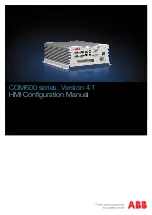
Every SNMP management system contains an MIB. SNMP can be used to configure, con-
trol and administrate various network components from one system. Such an SNMP tool is
included on your device: the Configuration Manager. As SNMP is a standard protocol, you
can use any other SNMP managers, e.g. HPOpenView.
For more information on the SNMP versions, see the relevant RFCs and drafts:
• SNMP V. 1: RFC 1157
• SNMP V. 2c: RFC 1901 - 1908
• SNMP V. 3: RFC 3410 - 3418
23.4.1 SNMP Trap Options
In the event of errors, a message - known as a trap packet - is sent unrequested to monitor
the system.
In the
External Reporting
->
SNMP
->
SNMP Trap Options
menu, you can configure the
sending of traps.
The menu
External Reporting
->
SNMP
->
SNMP Trap Options
consists of the following
fields:
Fields in the SNMP Trap OptionsBasic Parameters menu
Field
Description
SNMP Trap Broadcast-
ing
Select whether the transfer of SNMP traps is to be activated.
Your device then sends SNMP traps to the LAN's broadcast ad-
dress.
The function is activated by selecting
#/
.
The function is disabled by default.
SNMP Trap UDP Port
Only if
SNMP Trap Broadcasting
is enabled.
Enter the number of the UDP port to which your device is to
send SNMP traps.
Any whole number is possible.
The default value is
.
SNMP Trap Com-
munity
Only if
SNMP Trap Broadcasting
is enabled.
Funkwerk Enterprise Communications GmbH
23 External Reporting
R1xxx/R3xxx/R4xxx
415
















































